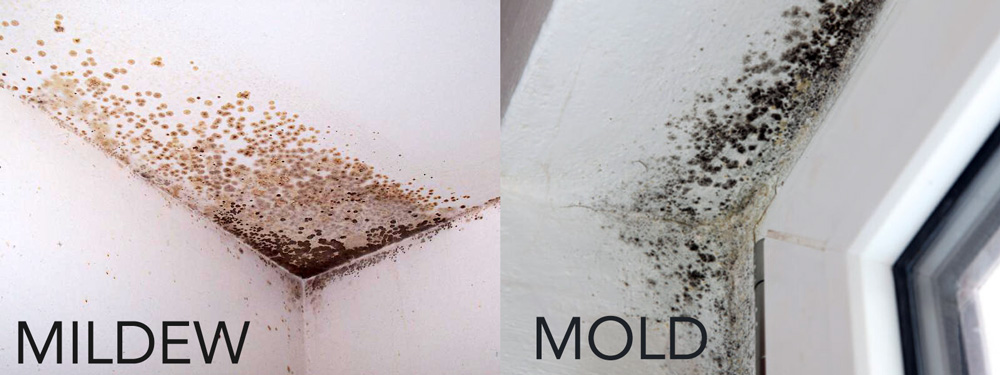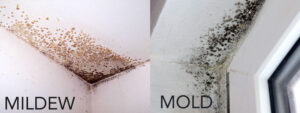
The basic difference between mold and mildew starts with their physical appearance. Mildew is typically grey or white. Mold, on the other hand, can be found in a range of colors but is most commonly brown or green. We’ll look at some of the other distinctions and similarities between mildew and mold in this section.

The ideal growing conditions
Moisture and warmth are required for mildew and mold to flourish. Mildew thrives in temperatures ranging from 77°F to 88°F and humidity levels ranging from 62 to 93 percent. Mold, on the other hand, thrives in environments with a humidity level of 60% or higher and at all temperatures. Mold can thrive even in the most extreme places and in extreme conditions, such as Antarctica!
Where and how do they survive?
Plants and damp organic material, such as textiles, paper-based items, ceilings, walls, and floors, are the most common places to encounter mildew. Food, paper and wood goods, insulation, carpet, paint, and furniture are all examples of living and dead organic material that mold can grow on.
What types of illnesses are related to mildew and mold?
Mildew can cause breathing problems, alongside a lot of other illnesses. Wheezing, congestion, headaches, and irritation of the eyes, nose, and throat are some of the common symptoms. Mold infestation, on the other hand, can trigger this and several other symptoms. Mold has been linked to lungs inflammation, liver infections, and impaired cognitive function. However, the consequences vary depending on the mold type.
Is there anything that you can do to keep mold and mildew from growing in your home?
Now that we have discussed the differences between mold and mildew, you are presumably asking about how to avoid and treat them both in your house. The finest approach to ensuring your family is healthy and home free of damage is to prevent it.
What can you do to keep mold and mildew at bay?
- Keep all areas dry: damp surfaces are common in the bathroom and kitchen. Leaving them dry will help keep mold and mildew at bay. Also, remember to let your washing machine air out after each use.
- Use a dehumidifier: to keep your home at an ideal humidity level (between 40 and 50 percent) to prevent mold and mildew growth.
- Replace your air filters regularly: HVAC filters, like HEPA filters, are susceptible to mold and mildew growth. You may avoid this by changing them frequently.
- Check for mold and mildew regularly: The sooner you detect it, the quicker it is to treat.
- Allowing the indoor air to circulate: stagnant air retains humidity, creating the ideal setting for mold and mildew to thrive. Keep windows open and use fans to keep the air moving in your home.
- Use an air purifier: Indoor air purifiers can eliminate mold spores from the air in your house, preventing clustering and growth. Air purifiers are particularly good for mold since they fully destroy it, eliminating the possibility of it growing on the filter surface and being released back into the air.
Here’s a brief overview of the differences between mold and mildew
Remember that the key differences between mold and mildew are:
- Texture
- Color
- Growth period
- The severity of potential health hazards imposed by each
- What kind of damage can they do to your place?
Even though mildew is less dangerous than mold, both should be considered as potential health hazards. Preventative steps will help to keep your house and family safe. If mold or mildew is discovered, there are several options for removing it. However, it is always recommended that you consult a professional mold removal expert.
Have Mildew or Mold Growing?
If you have any issues with mildew or mold, call Bakken Mold squad. Our restoration team members are trained mold removal experts. Call us today at 7015002533, and we’ll help you get your home or business back to its pre-mildew or pre-mold condition.